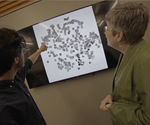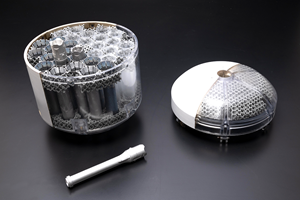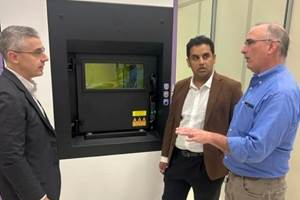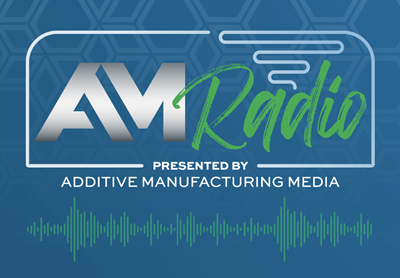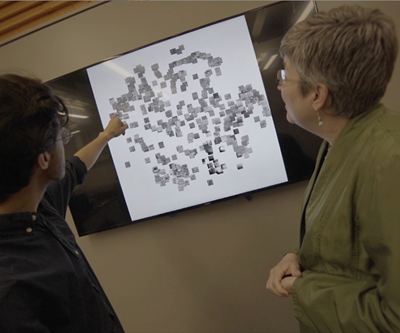Spatter, Surrogate Modeling and More Advanced Manufacturing Research Happening at Carnegie Mellon University: AM Radio #53
In this trip report, we discuss research at the Manufacturing Futures Institute and Next Manufacturing Center, both under CMU’s umbrella, to advance industry with robotics, AI and additive manufacturing.
Share
Read Next
Earlier this year, I traveled to Pittsburgh, Pennsylvania, to learn about advanced manufacturing research happening within two institutes associated with Carnegie Mellon University. First, I visited the lab facilities for the Manufacturing Futures Institute or MFI, housed inside a repurposed steel mill structure today known as Mill 19.
Mill 19 is actually a set of three new buildings built beneath the frame of a former steel mill and a large array of solar panels. The Manufacturing Futures Institute manages two floors of the southernmost building, closest to the camera.
Dr. Sandra DeVincent Wolf, executive director of the MFI, explains how the Institute is using LEGO bricks as a tool to explore robotic assembly and disassembly.
The MFI seeks to advance the digital transformation of manufacturing, which includes robotics, digital twins, generative design and more in addition to additive manufacturing (AM).
I also learned about the Next Manufacturing Center, a sister institute dedicated solely to AM, and its research to model spatter inside laser powder bed fusion 3D printers. In this episode of AM Radio, I share my observations with Pete Zelinski and we discuss the promise of artificial intelligence, robotics, surrogate modeling and more for the future of manufacturing.
Transcript
Peter Zelinski 00:05
How is artificial intelligence advancing additive manufacturing, and what does it have to do with spatter and steel mills? Stephanie Hendrixson takes us inside Mill 19 and AM research led by Carnegie Mellon University in this episode of AM Radio. Stay tuned.
Fiona Lawler 00:35
This episode of AM Radio is brought to you by the build up a twice weekly newsletter from additive manufacturing media featuring short articles on the latest applications in am that you won't find anywhere else. Find the URL in our show notes to sign up and join our growing reader community.
Stephanie Hendrixson 00:54
So Stephanie, I think it's time for another one of our post-adventure trip reports.
Stephanie Hendrixson 00:59
All right. Sounds good.
Peter Zelinski 01:01
So you just came back from a trip to Carnegie Mellon University in the Pittsburgh area, and I think you saw their like, manufacturing research facilities there.
Stephanie Hendrixson 01:11
Yeah. So I visited Carnegie Mellon with our colleague, Jodee McElfresh. She came along as kind of like my photographer who was sort of following me around with a camera, which, well, is actually a phone these days, but we were there to visit these two different facilities at Carnegie Mellon. Get lots of B roll. We actually did some cool parts interviews and walked away with a couple of parts, which I probably won't talk about here until the episodes are ready. But we visited two different facilities that Carnegie Mellon uses for different types of manufacturing, different types of additive manufacturing research. So we started actually pretty far away from the main campus and the city. We were sort of along one of the rivers in this area that's just like a bunch of old steel mills and like other like big industrial buildings, many of which have been repurposed for other things, and we went to see one of these things. So I actually have a picture here, and I'm gonna show you what this facility looked like.
Peter Zelinski 02:09
Alright, so I'm looking at a picture of this facility, and it's like lots of framework around what seem like, like, like steel frames and girders around what look like smaller buildings kind of nestled in the crook beneath the this framework and the and the structural frame around it. It's like, it's not a contiguous building. It's like this metal framework around what appears to be a smaller a row of smaller buildings beneath it, yeah.
Stephanie Hendrixson 02:47
So what you're looking at is called Mill 19. It's an old steel mill, but as you noted, they kind of gutted the whole thing, everything except for that steel framing. And now underneath that frame, there are these new three state of the art buildings, and on top of the frame is actually the largest single slope solar array in the United States, unless somebody has built a bigger one since it went up in 2020 it has almost 5,000 panels. And according to Scalo Solar, the company that installed it, this array can power the equivalent of 264 homes.
Peter Zelinski 03:18
So the solar panels are directly powering their manufacturing equipment.
Stephanie Hendrixson 03:23
Yeah. So according to an article that I found in this publication called Solar Power World, this solar array is providing enough electricity to meet all the power needs of all three buildings.
Stephanie Hendrixson 03:33
So tell me more about Mill 19 and what you saw there, what's going on underneath all those solar panels?
Stephanie Hendrixson 03:38
So Mill 19 is actually owned by the RIDC, the regional Industrial Development Corporation. There are multiple businesses and organizations in there, including some like Advanced Robotics for Manufacturing or ARM that are associated with Carnegie Mellon. But there are commercial tenants too. So we actually saw like a driverless vehicle in the parking lot, for example, because that's what one of these businesses is working on. But Carnegie Mellon, actually it's their Manufacturing Futures Institute, or MFI, is the anchor tenant of the complex. So MFI manages the first two floors of the southernmost building, so the one that was closest to the camera in that photo. And the goal of the MFI is to advance the digital transformation of manufacturing. So that obviously includes additive manufacturing, but also things like digital twins, generative design. We actually spend a lot of time talking about robotics as well. And inside that building at Mill 19, there are labs for different focuses like robotics and am so this is one of the physical locations where a lot of MFI is collaboration and development and experimentation happens along with industry partners and some Carnegie Mellon students as well.
Peter Zelinski 04:44
Talk to me more about digital manufacturing and the different pieces you described coming together, like the robotics aspect of it, for example. Like, did you see research happening or work going on that suggests what they're listening or aspiring to in terms of a more digital workflow?
Stephanie Hendrixson 05:04
So a lot of what we saw was very interdisciplinary, and that's something that this institute in particular, really prides itself on. That's, I guess, a condition to be an institute at a university. You have to be cross disciplinary. So we met Sandra DeVincent Wolf, who is the executive director, and she was really proud of the fact that the manufacturing Futures Institute collaborates with six out of seven colleges at Carnegie Mellon. And so you mentioned robotics, and that was one of our first stops. We went to this lab where there were all these little robotic arms on these tables, and they were studying ways of like training these robots to assemble and disassemble things. And as they were figuring out, like, how to set up this lab, they were trying to come up with something like, what's something that a robot could work on and put together and take apart? And would it result in a lot of waste? Like, wouldn't be hazardous? Any ideas what that might be?
Stephanie Hendrixson 05:58
Do you mean an actual end product, or a good assembly exercise, or, like, give me some parameters,
Stephanie Hendrixson 06:07
A good assembly exercise.
Peter Zelinski 06:11
LEGOs, Tinker Toys.
Stephanie Hendrixson 06:14
So I got a photo from this lab visit, and I think you'll be able to tell what they're what they're putting together.
Peter Zelinski 06:20
The robots are building with LEGOs.
Stephanie Hendrixson 06:24
Yes.
Peter Zelinski 06:24
And so are they building? They must be aiming to build something specific with Legos, right? Do they have, like, a design they're aiming for?
Stephanie Hendrixson 06:33
Well, so that's kind of where all of this cross disciplinary stuff comes into play. What they're really working on here is a lot of different things at once. Early on, the research with the robots was sort of like designing the right kind of grippers that would let them actually manipulate LEGOs. And like, you know, prying LEGOs apart is kind of difficult, so they had to come up with solutions for that. Now they're at the point where they are working on, like machine learning solutions, where you could tell a robot much in the way that you talked in Chat GPT, like I want to build a house. And using these algorithms that they're developing, the software could come up with a two dimensional design for this house, or maybe even a three dimensional design. Look at the inventory of LEGOs that are available and then feed that to the robot so it could be assembled. And so they're kind of bringing together all of these different aspects of automation and machine learning and and also vision systems. We talked about that, and sort of, you know, how do you protect humans around robots? And so there's a lot going on just with this robot that is putting together LEGOs and taking them apart again.
Peter Zelinski 07:36
It's really cool. In the photo you showed me, they're they're Yaskawa robots. They're small, they're tabletop size, but they're industrial robots. So there is an industrial, a manufacturing aim for all this. Take me a step further. How did your conversation go beyond LEGOs into how this could apply to manufacturing?
Stephanie Hendrixson 07:55
Well, so those are not cobots, and that was kind of my assumption, like walking in and just seeing these robot arms just out in the in the open, but yeah, as you point out, they are industrial robots. And so as we were talking, Sandra starts pointing around at these cameras that are above us. And what the cameras are doing is creating light curtains. And they have the system, I think, set up so that you can either make a light curtain around the robot, and so it's it's sort of enclosing the area that the robot can move in. And if a human enters, crosses the light curtain and enters that space, the robot will stop, or you can build a light curtain around people, and so the cameras can be watching for people to walk into this space and adjust the robots accordingly.
Peter Zelinski 08:34
I love this. I know this is AM Radio, and we talk about additive manufacturing, but, but additive manufacturing connects to something larger, and it connects to the ways that manufacturing is changing and advancing. Let's take a quick break and then get more into AM.
Fiona Lawler 08:52
This episode of AM Radio is brought to you by The BuildUp. If you like the podcast, but want more frequent updates on what's happening in additive manufacturing, sign up for The BuildUp using the link in today's show notes. Twice a week, you'll get short original articles on the latest applications in am delivered right to your inbox. Every issue includes insights from our most recent reporting, links to useful resources and the latest news and interesting things happening in the world of additive stay informed about AM's advance into production. Visit the link in our show notes to sign up and join the reader community today.
Peter Zelinski 09:31
In the first half of the episode, we talked about robots and AI, but now take us to additive manufacturing. What additive equipment did you see, and how are they using it?
Stephanie Hendrixson 09:41
Yeah, so this robotics lab was up on like the mezzanine floor, and then we went downstairs to see the additive capability in this facility. So everything that we talked about there was metal 3D printing. They've got two machines from Trumpf, which I actually haven't seen a lot of out in the wild. So they've got the powder directed energy deposition, or DED platform, and also a Trumpf laser powder bed fusion printer, which we got to see running a little bit later in the day. We also spent some time talking about their wire arc additive manufacturing, or WAAM machine from Lincoln Electric. So you and I have seen similar systems actually at Lincoln Electric in Cleveland that are basically the size of a room, but this was a scaled-down lab size machine, which I don't think I've seen before, and I should say the MFI also has access to another AM lab on the main university campus, which has some other options for laser powder bed fusion, as well as electron beam melting and binder jetting.
Peter Zelinski 10:33
Okay, so that's a lot of equipment, and that's way beyond building with LEGOs. What's an example of how their digital manufacturing vision or research was playing out on one of those machines?
Stephanie Hendrixson 10:45
So I'm gonna keep talking about computer science and machine learning, because that's a big area of research focus at Carnegie Mellon, and it feeds out into what they're doing with manufacturing a lot. And so every machine that we saw, I think, had lots of sensors hooked up to it. There were, you know, sensing capabilities and monitoring capabilities above and beyond what you would get off the shelf, the Trumpf machine, the powder bed fusion machine that I mentioned, had a high-speed camera on top. And so as we sort of spent the day on campus, we actually ended up back at Mill 19, and ended up back in front of this printer. And there was a team of students running an experiment. They were just printing, like, really tiny little sample parts, because they're studying spatter, and that was something that we learned about throughout the day. And so we were trying to get some B roll of the printer going, because, you know, like the dancing laser is kind of cool footage to have, but they were going layer by layer to be able to capture images of the spatter and like what was happening inside the printer. And so these parts were so small that the laser would just go by. It would turn on. It would just go by like that.
Peter Zelinski 11:48
Because at each layer, it's the system's looking at spatter, and machine learning is comparing build parameters and ambient conditions picked up by sensing, correlating all of that with the spatter pattern it saw, so as to learn how to somehow do spatter-less production?
Stephanie Hendrixson 12:11
I think that's broadly the long-term goal, but what they're working on right now has to do with, how do you model spatter? So just to talk about spatter for a moment, this is something that happens. You know, when your laser is hitting the melt pool, sometimes some of that melted material can be thrown to other parts of the build plate. Can land on the powder, can land on your part. I learned that part of the role of the gas inside of the machine, typically argon, is to capture and, like, carry away the spatter so it doesn't land anywhere. But it doesn't necessarily work as intended. And so if you can predict where the spatter is going to go, then you can maybe orient your parts in a particular way, place them in a specific spot on the build plate, and like, think about your build a little bit differently, manipulate the parameters accordingly.
Peter Zelinski 12:53
Designed for spatter. That is really cool.
Stephanie Hendrixson 12:56
And this is something that you could simulate. The problem is that simulation takes so much computing power, and it can take so long that it becomes impractical. If it takes you days or weeks to simulate the spatter that's going to happen inside of your build, that's time you could have spent actually running the build. It becomes sort of not worth it anymore. So one of the things we talked about a lot over the course of the day is this idea of surrogate modeling, which is different from simulation. It's more machine learning and AI, you train a model on data sets from experiments, and it forms connections, kind of like a neural network, so you end up with this more black box model where you don't necessarily know what's literally going on inside, but it can really quickly show you expected behavior, much faster than a conventional simulation.
Peter Zelinski 13:38
I feel like this is something we've been talking about a long time, and has been clear for a long time, that additive manufacturing, the metal 3D printing processes in particular, and laser powder bed fusion, most particular of all, are systems in which there is a lot happening all at once, a lot of parameters that are effective, a lot of effects that are germane, all at once, and sensing plus AI will be the avenue to greater process control like that's been clear for a long time, but now we're starting to see experiences like this, where we see exactly how that's going to play out, and what these artificial intelligence systems, like specifically what kind of smarts they're going to develop to aid the process.
Stephanie Hendrixson 14:26
Yeah. And so just to give you an example of that, one of the researchers that we met, his name is Amir Barati Farimani, and he's an associate professor of mechanical engineering and also works in the Mechanical and Artificial Intelligence Laboratory [MAIL]. The example that he gave was, in the past, they've done simulations of spatter and that can take up to a week to generate. In contrast with one of the surrogate models that they're working on, they can do it in about an hour. So it's a it's a huge time savings, if we can figure this out.
Peter Zelinski 14:58
Can I say, at the very start of this conversation, you mentioned the things that this lab is concerned with, digital manufacturing and the elements of that robotics additive. And you mentioned digital twin also. And it kind of sounds like this use of AI is something different than alternative to a digital twin. Like, is that is that fair?
Stephanie Hendrixson 15:20
I think that might be fair. The interesting thing that I learned about the surrogate model is that the data that you use that you can feed into the surrogate model. It doesn't have to all be from experiments. You can actually take simulation data and feed it in as well, and like all of that can be used to create this model. So it is sort of like a weird amalgamation of literally what happened in the physical world, but maybe also what you were able to simulate, or information that's coming from, like, a quote, unquote, digital twin.
Peter Zelinski 15:48
Oh, digital twins can be making the AI smarter too.
Stephanie Hendrixson 15:52
Maybe? I am not an AI scientist. I don't know that for sure, but that was sort of the the impression that I got.
Peter Zelinski 15:58
All right, we've talked about robots, we've talked about AI, we've talked about additive Is there anything else you saw that you want to talk about?
Stephanie Hendrixson 16:03
Yeah, I guess I just want to quickly outline the full scope of what we saw. We spent a lot of time in the manufacturing Futures Institute lab at Mill 19, but afterwards, we also went to the main Carnegie Mellon campus in downtown Pittsburgh, and visited the additive lab there, and we learned about this other organization under the university umbrella that does specifically focus on additive manufacturing research, which is called the Next Manufacturing Center. Sandra is a codirector of that, along with Jack Beuth and Tony Rollett, who were the two experts that we interviewed for The Cool Parts Show episodes that will be coming out soon. But similar to the MFI, the Next Manufacturing Center also does a lot of collaboration with industry partners, and the nature of that collaboration has changed in an interesting way over the last almost 10 years. It was founded in 2015 and Sandra told us that at the beginning, there were a lot of companies that wanted to become part of this consortium and sponsor research from the center that was really, like, broadly applicable. Just, you know, can additive manufacturing do X, Y or Z? Can it be used in this type of industry? How do we think about it, like those types of big questions. And over the last few years, there's been a shift. Now companies are coming in at sort of, like, lower membership levels with really, really specific problems to solve. They've already decided they're going to use additive they already have a already have a good sense of it, but they've run up against, like, some really specific roadblock that they would like Carnegie Mellon to help them to solve. And so I thought that was a really interesting kind of shift.
Peter Zelinski 17:32
It is, that's really cool, and what you're saying is the promise of additive manufacturing draws nearer to fulfillment, and the problems get smaller and tighter and more specific and focused.
Stephanie Hendrixson 17:45
Yeah, and that, to me, kind of it kind of gels with the way that our reporting has changed over time, and sort of like my sense of where industry is. Like, it's not so much that companies need to be convinced that additive is worthwhile or worth exploring. It's that a lot of these companies are now adopting additive and they're trying to figure out how to make it optimized for the thing that they're trying to produce.
Peter Zelinski 18:05
That seems like a good place to end. If you want to see the photos we described and learn more about Carnegie Mellon Mill 19 and any of the things we discussed, you can find a link to Stephanie's story in the show notes. Thank you for listening.
Stephanie Hendrixson 18:19
AM Radio is recorded with help from Austin Grogan, the show is edited by Jodee McElfresh and me, Stephanie Hendrixson. Our artwork is by Kate Schrand. AM Radio and Additive Manufacturing Media are products of Gardner Business Media located in the Queen City, Cincinnati, Ohio. I'm Stephanie Hendrixson. Thanks for listening.
Related Content
VulcanForms Is Forging a New Model for Large-Scale Production (and It's More Than 3D Printing)
The MIT spinout leverages proprietary high-power laser powder bed fusion alongside machining in the context of digitized, cost-effective and “maniacally focused” production.
Read More3D Printed NASA Thrust Chamber Assembly Combines Two Metal Processes: The Cool Parts Show #71
Laser powder bed fusion and directed energy deposition combine for an integrated multimetal rocket propulsion system that will save cost and time for NASA. The Cool Parts Show visits NASA’s Marshall Space Flight Center.
Read More3D Printed Lattice for Mars Sample Return Crash Landing: The Cool Parts Show Bonus
NASA Jet Propulsion Laboratory employs laser powder bed fusion additive manufacturing plus chemical etching to create strong, lightweight lattice structures optimized to protect rock samples from Mars during their violent arrival on earth.
Read MoreNew Zeda Additive Manufacturing Factory in Ohio Will Serve Medical, Military and Aerospace Production
Site providing laser powder bed fusion as well as machining and other postprocessing will open in late 2023, and will employ over 100. Chief technology officer Greg Morris sees economic and personnel advantages of serving different markets from a single AM facility.
Read MoreRead Next
Artificial Intelligence and Additive Manufacturing Are Connected: AM Radio #36
Stephanie Hendrixson and Peter Zelinski discuss how AI and AM go together. There are already plenty of uses of AI in 3D printing for design, process planning and process monitoring, and the link will grow stronger as the “frictionlessness” of AI blends with that of AM.
Read MoreCarnegie Mellon Helps Industry, Students Prepare for a Manufacturing Future with AM and AI
Work underway at the university’s Next Manufacturing Center and Manufacturing Futures Institute is helping industrial additive manufacturers achieve success today, while applying artificial intelligence, surrogate modeling and more to solve the problems of the future.
Read MoreComputer Vision System Automates Characterization of Metal Powder
A computer vision system that has learned to classify metal powders could speed material qualification and advance machine learning in additive manufacturing.
Read More
.jpg;width=70;height=70;mode=crop)


